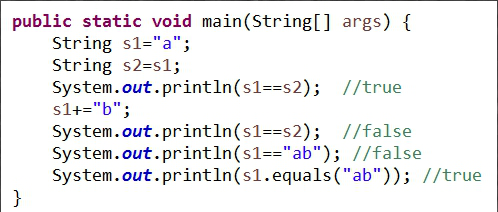
为什么会有上述的输出结果?从中你又能总结出什么?
给字串变量赋值意味着:两个变量(s1,s2)现在引用同一个字符串对象“a”! String对象的内容是只读的,使用“+”修改s1变量的值,实际上是得到了一个新的字符串对象,其内容为“ab”,它与原先s1所引用的对象”a”无关,所以,s1==s2返回false; 代码中的“ab”字符串是一个常量,它所引用的字符串与s1所引用的“ab”对象无关。 String.equals()方法可以比较两个字符串的内容。
2.请查看String.equals()方法的实现代码,注意学习其实现方法。
public class StringEquals {
/**
* @param args the command line arguments
*/
public static void main(String[] args) {
String s1=new String("Hello");
String s2=new String("Hello");
System.out.println(s1==s2);
System.out.println(s1.equals(s2));
String s3="Hello";
String s4="Hello";
System.out.println(s3==s4);
System.out.println(s3.equals(s4));
}
}
String类对equals()方法进行了覆盖,只要引用指向的对象的内容是一样的就认为他们相等。而Object类默认的equals()方法就是比较两个引用指向的对象本身,如果指向同一个对象,那就认为他们是相等的,否则不相等,除非像String类那样对其进行覆盖重写。
3.
String类的方法可以连续调用: String str="abc"; String result=str.trim().toUpperCase().concat("defg"); 请阅读JDK中String类上述方法的源码,模仿其编程方式,编写一个MyCounter类,它的方法也支持上述的“级联”调用特性,其调用示例为: MyCounter counter1=new MyCounter(1); MyCounter counter2=counter1.increase(100).decrease(2).increase(3); ….
package kehouzuoye;
public class MyCounter {
int num;
MyCounter(int a){
num=a;
}
MyCounter increase(int b) {
this.num+=b;
return this;
}
MyCounter decrease(int c) {
this.num-=c;
return this;
}
public static void main(String[] args) {
// TODO Auto-generated method stub
MyCounter counter1=new MyCounter(1);
MyCounter counter2=counter1.increase(100).decrease(2).increase(3);
System.out.println(counter2.num);
}
Length():获取字串长度
charAt():获取指定位置的字符
getChars():获取从指定位置起的子串复制到字符数组中(它有四个参数,在示例中有介绍)
replace():子串替换
toUpperCase()、 toLowerCase():大小写转换
trim():去除头尾空格:
toCharArray():将字符串对象转换为字符数组